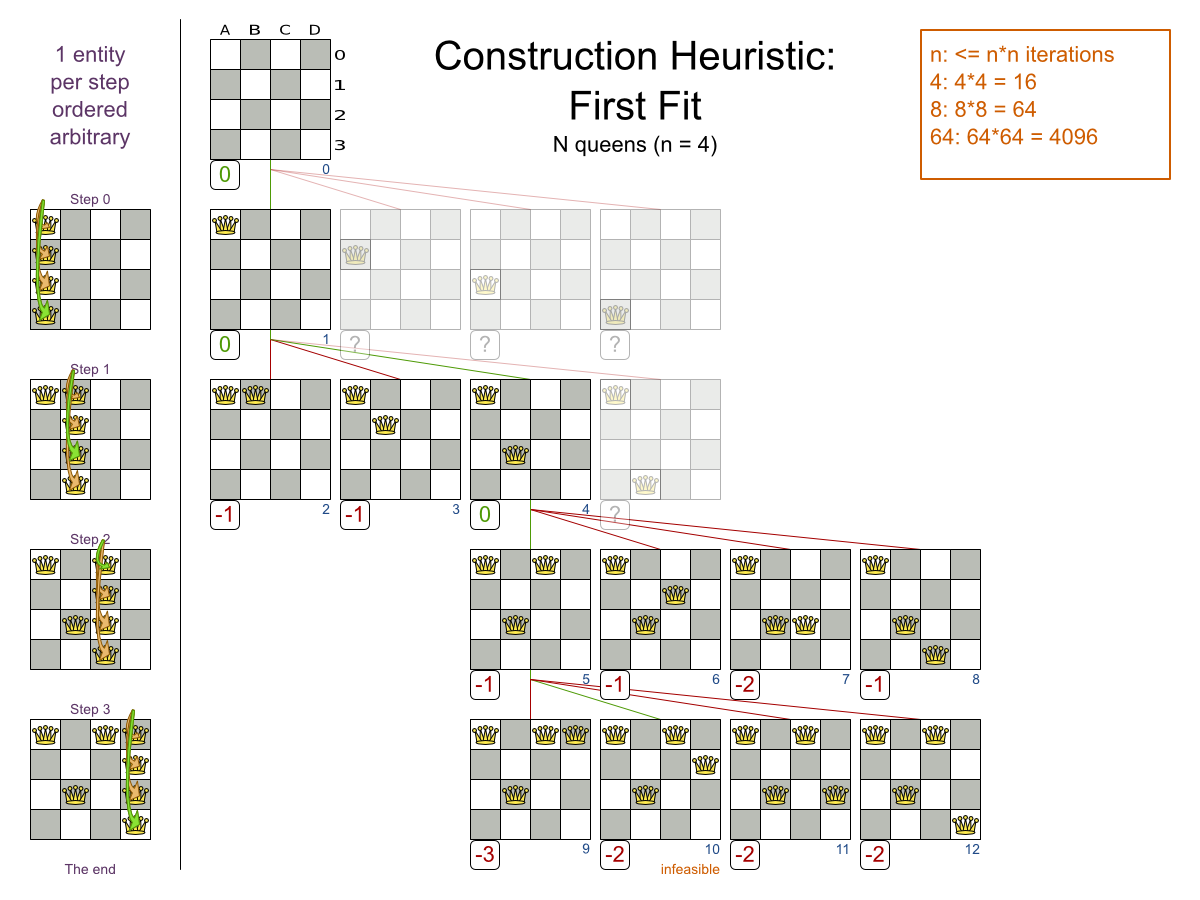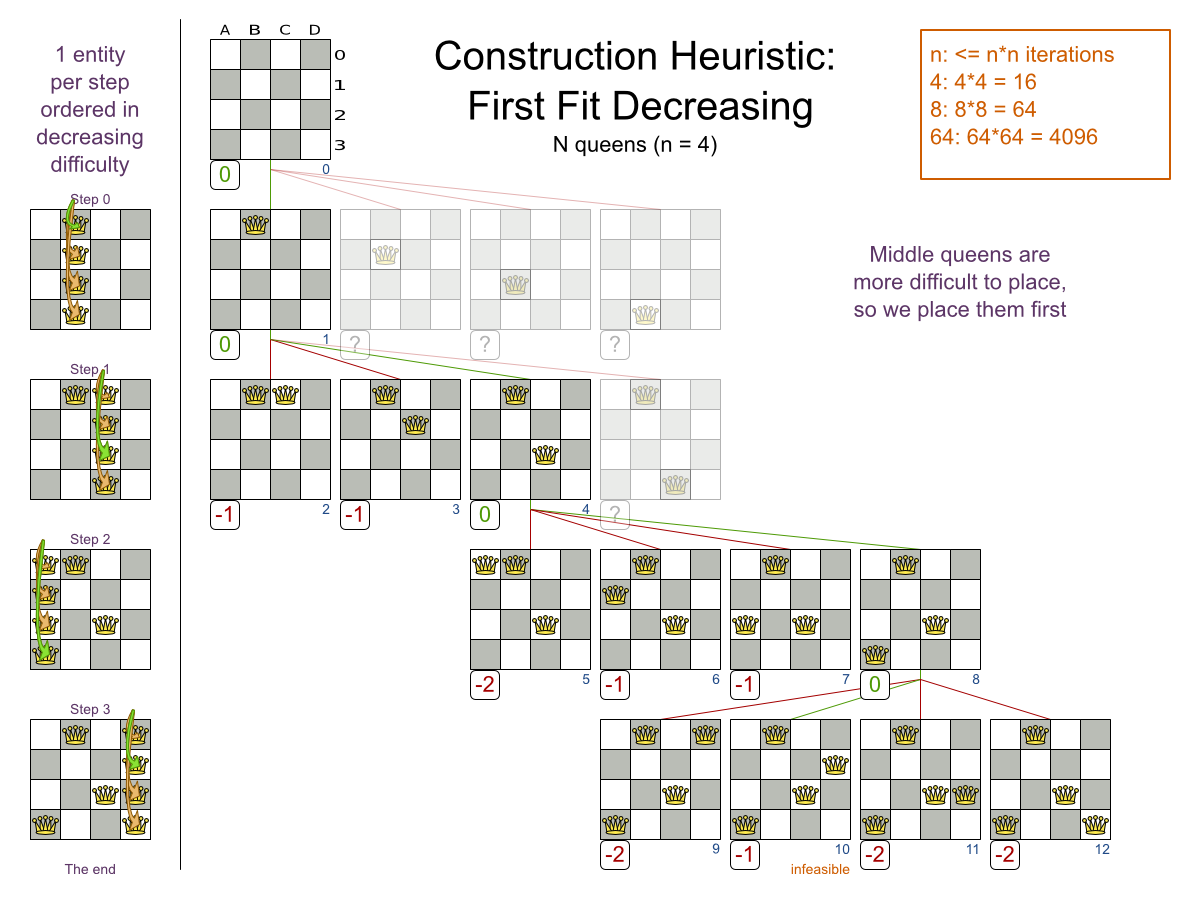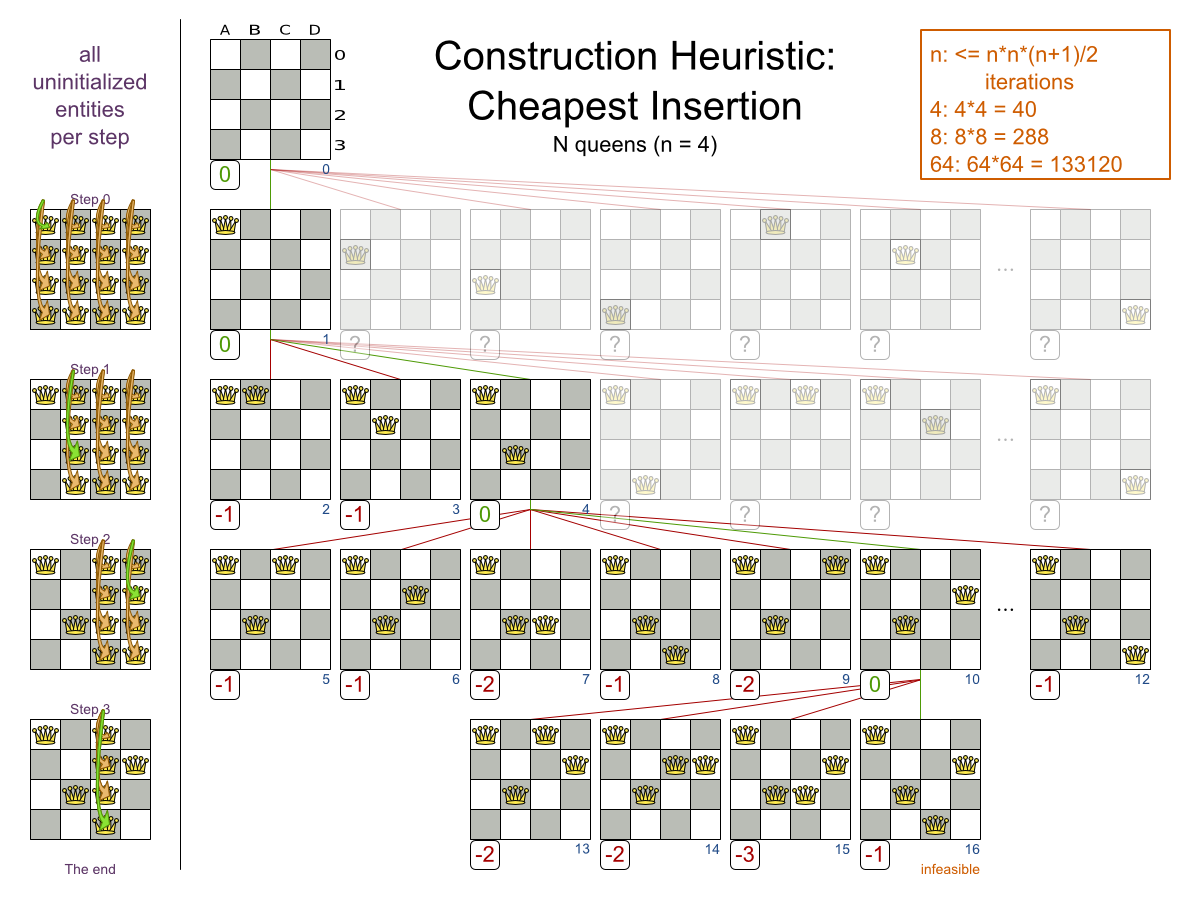Chapter 9. Construction Heuristics
9.1. Overview
A construction heuristic builds a pretty good initial solution in a finite length of time. Its solution isn’t always feasible, but it finds it fast so metaheuristics can finish the job.
Construction heuristics terminate automatically, so there’s usually no need to configure a Termination on the construction heuristic phase specifically.
9.2. First Fit
9.2.1. Algorithm Description
The First Fit algorithm cycles through all the planning entities (in default order), initializing 1 planning entity at a time. It assigns the planning entity to the best available planning value, taking the already initialized planning entities into account. It terminates when all planning entities have been initialized. It never changes a planning entity after it has been assigned.
Notice that it starts with putting Queen A into row 0 (and never moving it later), which makes it impossible to reach the optimal solution. Suffixing this construction heuristic with metaheuristics can remedy that.
9.2.2. Configuration
Configure this solver phase:
<constructionHeuristic>
<constructionHeuristicType>FIRST_FIT</constructionHeuristicType>
</constructionHeuristic>
<constructionHeuristic>
<constructionHeuristicType>FIRST_FIT</constructionHeuristicType>
</constructionHeuristic>
If the InitializingScoreTrend is ONLY_DOWN, this algorithm is faster: for an entity, it picks the first move for which the score does not deteriorate the last step score, ignoring all subsequent moves.
For advanced configuration, see Allocate Entity From Queue.
9.3. First Fit Decreasing
9.3.1. Algorithm Description
Like First Fit, but assigns the more difficult planning entities first, because they are less likely to fit in the leftovers. So it sorts the planning entities on decreasing difficulty.
Requires the model to support planning entity difficulty comparison.
One would expect that this algorithm has better results than First Fit. That’s usually the case, but not always.
9.3.2. Configuration
Configure this solver phase:
<constructionHeuristic>
<constructionHeuristicType>FIRST_FIT_DECREASING</constructionHeuristicType>
</constructionHeuristic>
<constructionHeuristic>
<constructionHeuristicType>FIRST_FIT_DECREASING</constructionHeuristicType>
</constructionHeuristic>
If the InitializingScoreTrend is ONLY_DOWN, this algorithm is faster: for an entity, it picks the first move for which the score does not deteriorate the last step score, ignoring all subsequent moves.
For advanced configuration, see Allocate Entity From Queue.
9.4. Weakest Fit
9.4.1. Algorithm Description
Like First Fit, but uses the weaker planning values first, because the strong planning values are more likely to be able to accommodate later planning entities. So it sorts the planning values on increasing strength.
Requires the model to support planning value strength comparison.
Do not presume that this algorithm has better results than First Fit. That’s often not the case.
9.4.2. Configuration
Configure this solver phase:
<constructionHeuristic>
<constructionHeuristicType>WEAKEST_FIT</constructionHeuristicType>
</constructionHeuristic>
<constructionHeuristic>
<constructionHeuristicType>WEAKEST_FIT</constructionHeuristicType>
</constructionHeuristic>
If the InitializingScoreTrend is ONLY_DOWN, this algorithm is faster: for an entity, it picks the first move for which the score does not deteriorate the last step score, ignoring all subsequent moves.
For advanced configuration, see Allocate Entity From Queue.
9.5. Weakest Fit Decreasing
9.5.1. Algorithm Description
Combines First Fit Decreasing and Weakest Fit. So it sorts the planning entities on decreasing difficulty and the planning values on increasing strength.
Requires the model to support planning entity difficulty comparison and planning value strength comparison.
Do not presume that this algorithm has better results than First Fit Decreasing. That’s often not the case. However, it is usually better than Weakest Fit.
9.5.2. Configuration
Configure this solver phase:
<constructionHeuristic>
<constructionHeuristicType>WEAKEST_FIT_DECREASING</constructionHeuristicType>
</constructionHeuristic>
<constructionHeuristic>
<constructionHeuristicType>WEAKEST_FIT_DECREASING</constructionHeuristicType>
</constructionHeuristic>
If the InitializingScoreTrend is ONLY_DOWN, this algorithm is faster: for an entity, it picks the first move for which the score does not deteriorate the last step score, ignoring all subsequent moves.
For advanced configuration, see Allocate Entity From Queue.
9.6. Strongest Fit
9.6.1. Algorithm Description
Like First Fit, but uses the strong planning values first, because the strong planning values are more likely to have a lower soft cost to use. So it sorts the planning values on decreasing strength.
Requires the model to support planning value strength comparison.
Do not presume that this algorithm has better results than First Fit or Weakest Fit. That’s often not the case.
9.6.2. Configuration
Configure this solver phase:
<constructionHeuristic>
<constructionHeuristicType>STRONGEST_FIT</constructionHeuristicType>
</constructionHeuristic>
<constructionHeuristic>
<constructionHeuristicType>STRONGEST_FIT</constructionHeuristicType>
</constructionHeuristic>
If the InitializingScoreTrend is ONLY_DOWN, this algorithm is faster: for an entity, it picks the first move for which the score does not deteriorate the last step score, ignoring all subsequent moves.
For advanced configuration, see Allocate Entity From Queue.
9.7. Strongest Fit Decreasing
9.7.1. Algorithm Description
Combines First Fit Decreasing and Strongest Fit. So it sorts the planning entities on decreasing difficulty and the planning values on decreasing strength.
Requires the model to support planning entity difficulty comparison and planning value strength comparison.
Do not presume that this algorithm has better results than First Fit Decreasing or Weakest Fit Decreasing. That’s often not the case. However, it is usually better than Strongest Fit.
9.7.2. Configuration
Configure this solver phase:
<constructionHeuristic>
<constructionHeuristicType>STRONGEST_FIT_DECREASING</constructionHeuristicType>
</constructionHeuristic>
<constructionHeuristic>
<constructionHeuristicType>STRONGEST_FIT_DECREASING</constructionHeuristicType>
</constructionHeuristic>
If the InitializingScoreTrend is ONLY_DOWN, this algorithm is faster: for an entity, it picks the first move for which the score does not deteriorate the last step score, ignoring all subsequent moves.
For advanced configuration, see Allocate Entity From Queue.
9.8. Allocate Entity From Queue
9.8.1. Algorithm Description
Allocate Entity From Queue is a versatile, generic form of First Fit, First Fit Decreasing, Weakest Fit and Weakest Fit Decreasing. It works like this:
- Put all entities in a queue.
- Assign the first entity (from that queue) to the best value.
- Repeat until all entities are assigned.
9.8.2. Configuration
Simple configuration:
<constructionHeuristic>
<constructionHeuristicType>ALLOCATE_ENTITY_FROM_QUEUE</constructionHeuristicType>
</constructionHeuristic>
<constructionHeuristic>
<constructionHeuristicType>ALLOCATE_ENTITY_FROM_QUEUE</constructionHeuristicType>
</constructionHeuristic>Verbose simple configuration:
<constructionHeuristic>
<constructionHeuristicType>ALLOCATE_ENTITY_FROM_QUEUE</constructionHeuristicType>
<entitySorterManner>DECREASING_DIFFICULTY_IF_AVAILABLE</entitySorterManner>
<valueSorterManner>INCREASING_STRENGTH_IF_AVAILABLE</valueSorterManner>
</constructionHeuristic>
<constructionHeuristic>
<constructionHeuristicType>ALLOCATE_ENTITY_FROM_QUEUE</constructionHeuristicType>
<entitySorterManner>DECREASING_DIFFICULTY_IF_AVAILABLE</entitySorterManner>
<valueSorterManner>INCREASING_STRENGTH_IF_AVAILABLE</valueSorterManner>
</constructionHeuristic>
The entitySorterManner options are:
-
DECREASING_DIFFICULTY: Initialize the more difficult planning entities first. This usually increases pruning (and therefore improves scalability). Requires the model to support planning entity difficulty comparison. -
DECREASING_DIFFICULTY_IF_AVAILABLE(default): If the model supports planning entity difficulty comparison, behave likeDECREASING_DIFFICULTY, else likeNONE. -
NONE: Initialize the planning entities in original order.
The valueSorterManner options are:
-
INCREASING_STRENGTH: Evaluate the planning values in increasing strength. Requires the model to support planning value strength comparison. -
INCREASING_STRENGTH_IF_AVAILABLE(default): If the model supports planning value strength comparison, behave likeINCREASING_STRENGTH, else likeNONE. -
DECREASING_STRENGTH: Evaluate the planning values in decreasing strength. Requires the model to support planning value strength comparison. -
DECREASING_STRENGTH_IF_AVAILABLE: If the model supports planning value strength comparison, behave likeDECREASING_STRENGTH, else likeNONE. -
NONE: Try the planning values in original order.
Advanced detailed configuration. For example, a Weakest Fit Decreasing configuration for a single entity class with a single variable:
Per step, the QueuedEntityPlacer selects 1 uninitialized entity from the EntitySelector and applies the winning Move (out of all the moves for that entity generated by the MoveSelector). The mimic selection ensures that the winning Move changes (only) the selected entity.
To customize the entity or value sorting, see sorted selection. Other Selector customization (such as filtering and limiting) is supported too.
9.8.3. Multiple Variables
There are 2 ways to deal with multiple variables, depending on how their ChangeMoves are combined:
-
Cartesian product of the
ChangeMoves(default): All variables of the selected entity are assigned together. Has far better results (especially for timetabling use cases). -
Sequential
ChangeMoves: One variable is assigned at a time. Scales much better, especially for 3 or more variables.
For example, presume a course scheduling example with 200 rooms and 40 periods.
This First Fit configuration for a single entity class with 2 variables, using a cartesian product of their ChangeMoves, will select 8000 moves per entity:
With 3 variables of 1000 values each, a Cartesian product selects 1 000 000 000 values per entity, which will take far too long.
This First Fit configuration for a single entity class with 2 variables, using sequential ChangeMoves, will select 240 moves per entity:
Especially for sequential ChangeMoves, the order of the variables is important. In the example above, it’s better to select the period first (instead of the other way around), because there are more hard constraints that do not involve the room (for example: no teacher should teach 2 lectures at the same time). Let the Benchmarker guide you.
With 3 or more variables, it’s possible to combine the Cartesian product and sequential techniques:
9.8.4. Multiple Entity Classes
The easiest way to deal with multiple entity classes is to run a separate construction heuristic for each entity class:
9.8.5. Pick Early Type
There are several pick early types for Construction Heuristics:
NEVER: Evaluate all the selected moves to initialize the variable(s). This is the default if the InitializingScoreTrend is notONLY_DOWN.Copy to Clipboard Copied! Toggle word wrap Toggle overflow FIRST_NON_DETERIORATING_SCORE: Initialize the variable(s) with the first move that doesn’t deteriorate the score, ignore the remaining selected moves. This is the default if the InitializingScoreTrend isONLY_DOWN.Copy to Clipboard Copied! Toggle word wrap Toggle overflow NoteIf there are only negative constraints, but the InitializingScoreTrend is strictly not
ONLY_DOWN, it can sometimes make sense to apply FIRST_NON_DETERIORATING_SCORE. Use the Benchmarker to decide if the score quality loss is worth the time gain.FIRST_FEASIBLE_SCORE: Initialize the variable(s) with the first move that has a feasible score.Copy to Clipboard Copied! Toggle word wrap Toggle overflow If the InitializingScoreTrend is
ONLY_DOWN, useFIRST_FEASIBLE_SCORE_OR_NON_DETERIORATING_HARDinstead, because that’s faster without any disadvantages.FIRST_FEASIBLE_SCORE_OR_NON_DETERIORATING_HARD: Initialize the variable(s) with the first move that doesn’t deteriorate the feasibility of the score any further.Copy to Clipboard Copied! Toggle word wrap Toggle overflow
9.9. Allocate To Value From Queue
9.9.1. Algorithm Description
Allocate To Value From Queue works like this:
- Put all values in a round-robin queue.
- Assign the best entity to the first value (from that queue).
- Repeat until all entities are assigned.
9.9.2. Configuration
Simple configuration:
<constructionHeuristic>
<constructionHeuristicType>ALLOCATE_TO_VALUE_FROM_QUEUE</constructionHeuristicType>
</constructionHeuristic>
<constructionHeuristic>
<constructionHeuristicType>ALLOCATE_TO_VALUE_FROM_QUEUE</constructionHeuristicType>
</constructionHeuristic>Verbose simple configuration:
<constructionHeuristic>
<constructionHeuristicType>ALLOCATE_TO_VALUE_FROM_QUEUE</constructionHeuristicType>
<entitySorterManner>DECREASING_DIFFICULTY_IF_AVAILABLE</entitySorterManner>
<valueSorterManner>INCREASING_STRENGTH_IF_AVAILABLE</valueSorterManner>
</constructionHeuristic>
<constructionHeuristic>
<constructionHeuristicType>ALLOCATE_TO_VALUE_FROM_QUEUE</constructionHeuristicType>
<entitySorterManner>DECREASING_DIFFICULTY_IF_AVAILABLE</entitySorterManner>
<valueSorterManner>INCREASING_STRENGTH_IF_AVAILABLE</valueSorterManner>
</constructionHeuristic>Advanced detailed configuration. For example, a configuration for a single entity class with a single variable:
9.10. Cheapest Insertion
9.10.1. Algorithm Description
The Cheapest Insertion algorithm cycles through all the planning values for all the planning entities, initializing 1 planning entity at a time. It assigns a planning entity to the best available planning value (out of all the planning entities and values), taking the already initialized planning entities into account. It terminates when all planning entities have been initialized. It never changes a planning entity after it has been assigned.
Cheapest Insertion scales considerably worse than First Fit, etc.
9.10.2. Configuration
Simplest configuration of Cheapest Insertion:
<constructionHeuristic>
<constructionHeuristicType>CHEAPEST_INSERTION</constructionHeuristicType>
</constructionHeuristic>
<constructionHeuristic>
<constructionHeuristicType>CHEAPEST_INSERTION</constructionHeuristicType>
</constructionHeuristic>
If the InitializingScoreTrend is ONLY_DOWN, this algorithm is faster: for an entity, it picks the first move for which the score does not deteriorate the last step score, ignoring all subsequent moves.
For advanced configuration, see Allocate from pool.
9.11. Regret Insertion
9.11.1. Algorithm Description
The Regret Insertion algorithm behaves like the Cheapest Insertion algorithm. It also cycles through all the planning values for all the planning entities, initializing 1 planning entity at a time. But instead of picking the entity-value combination with the best score, it picks the entity which has the largest score loss between its best and second best value assignment. It then assigns that entity to its best value, to avoid regretting not having done that.
9.11.2. Configuration
This algorithm has not been implemented yet.
9.12. Allocate From Pool
9.12.1. Algorithm Description
Allocate From Pool is a versatile, generic form of Cheapest Insertion and Regret Insertion. It works like this:
- Put all entity-value combinations in a pool.
- Assign the best entity to best value.
- Repeat until all entities are assigned.
9.12.2. Configuration
Simple configuration:
<constructionHeuristic>
<constructionHeuristicType>ALLOCATE_FROM_POOL</constructionHeuristicType>
</constructionHeuristic>
<constructionHeuristic>
<constructionHeuristicType>ALLOCATE_FROM_POOL</constructionHeuristicType>
</constructionHeuristic>Verbose simple configuration:
<constructionHeuristic>
<constructionHeuristicType>ALLOCATE_FROM_POOL</constructionHeuristicType>
<entitySorterManner>DECREASING_DIFFICULTY_IF_AVAILABLE</entitySorterManner>
<valueSorterManner>INCREASING_STRENGTH_IF_AVAILABLE</valueSorterManner>
</constructionHeuristic>
<constructionHeuristic>
<constructionHeuristicType>ALLOCATE_FROM_POOL</constructionHeuristicType>
<entitySorterManner>DECREASING_DIFFICULTY_IF_AVAILABLE</entitySorterManner>
<valueSorterManner>INCREASING_STRENGTH_IF_AVAILABLE</valueSorterManner>
</constructionHeuristic>
The entitySorterManner and valueSorterManner options are described in Allocate Entity From Queue.
Advanced detailed configuration. For example, a Cheapest Insertion configuration for a single entity class with a single variable:
Per step, the PooledEntityPlacer applies the winning Move (out of all the moves for that entity generated by the MoveSelector).
To customize the entity or value sorting, see sorted selection. Other Selector customization (such as filtering and limiting) is supported too.


